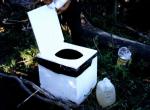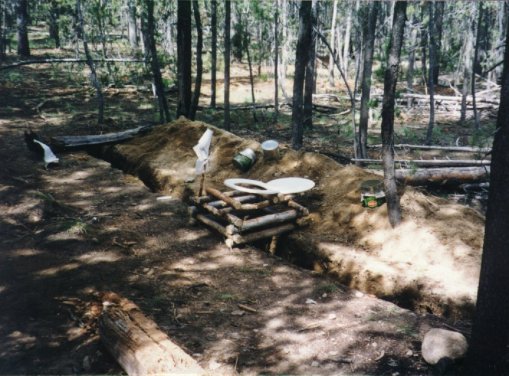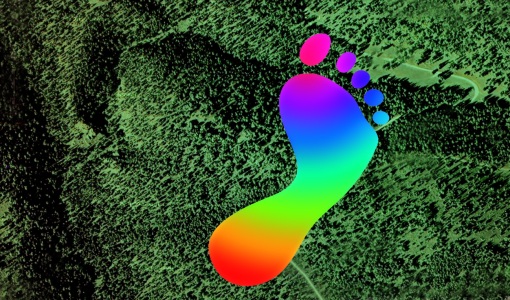
It seems odd that the few news story we’ve hear about the annual Rainbow Gathering in New Mexico have been positive. The opinions of Rainbow family members have been presented as if they were unchallenged facts. This makes us suspicious, so we decided to look into the possible impact of the Rainbow Gathering all by ourselves without any help from the Rainbow family. We don’t know why the alternative, environmentally conscious media chose not to do the same.
The question we want to address is:
What happens to the environment when over 10,000 people gather in OUR National Forest all at once?
We’re not interested in legalistic rhetoric or about whether or not they need a permit or emotional arguments about how well-intentioned they all are. We just want to investigate the environmental impact of such a gathering. We just want the facts.
We start with 2 basic truths about the gathering.
Each person attending a Rainbow Gathering consumes.
Each one of them produces waste products.
Let’s look at those waste products one by one:
HUMAN FECES
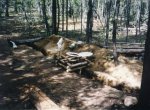
Unlike any other group with a non-commercial use permit, the Rainbows are allowed to dig slit trench latrines on Federal lands. Last week, the Rainbows were projecting 6,000 – 15,000 people, so let’s go with a nice round number like 10,000.
The average person on a high fiber diet produces 350 grams of stool per day.
10,000 people x 350 grams of stool x 6 days = 21,00000 grams or 21 metric tons or 23.14 tons of feces buried in the Santa Fe National Forest.
Flies and other insects walk upon the decaying feces, laying eggs to multiply their numbers. These same insects will then alight upon your people, animals and any food out in the open, thereby spreading disease organisms quite some distance from the latrines.
If it rains, and the weather report for this weekend gives a 40% chance of precipitation, the rainwater will carry a slurry of improperly disposed of human feces into groundwater, surface puddles, ponds, lakes and streams. This slurry will be laced with disease organisms that were in the feces to begin with or formed once it had been deposited. Other visitors to the National forest and animals can then come in contact with or drink this polluted water.
URINE
There are no port-o-potties at the rainbow gathering, so all the urine from all the people goes on the land or into the water.
Let’s calculate this:
The average person produces 800 to 2000 milliliters per day milliliters of urine per day.
10,000 people X 1400 ml X 6 days = 84,000,000 milliliters or 84,000 liters of urine or 22,222 gallons deposited in our National Forest to run into rivers and streams.
This introduces excess sodium, potassium nitrogen plus trace chemicals from anti-depressants, prescriptions drugs and hormones from birth control pills into a fragile wilderness.
TRASH
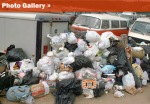
According to the Annenberg Foundation, the average American generates four pounds of solid trash per day. (Vegetarians are going generate more solid waste – vegetable and fruit peels etc.)
10,000 people X 4 lbs X 6 days = 240,000 pounds of trash that’s 120 TONS OF TRASH
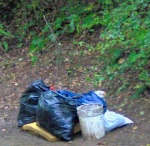
Rainbow Trash 2008
TRAILS
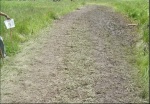
Every year, the Rainbows construct several miles of trails at their gathering site. The large amount of foot traffic inevitably compacts the soil. The compacted soil from the miles and miles of Rainbow trails damage sensitive ecosystems. There are also make-shift parking lots all over the gathering site. Vehicles compact the soil to an even greater extent.
Rainbows average 6 miles of compacted soil per gathering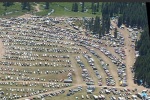
Rainbows also cut down trees to build structures such as ovens and “sweat lodges”. Last year they dug very
deep fire pits after they promised the Forest Service that they wouldn’t.
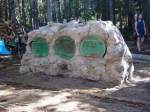 TAMPONS
TAMPONS
You’re supposed to change them every 2-3 hours so the average woman uses 8-12 /day average of 10 per day of her cycle. There’s a 1/12 chance of a woman of childbearing age being on her cycle so let’s estimate 315 menstruating women attending the gathering.
Let’s estimate
315 menstruating women X 6 days X 10 tampons /day = 18,900 tampons
Most tampons and sanitary napkins contain polyester and other synthetic fibers that do not bio-degrade. They are thrown into latrines, along with plastic applicators and buried with cigarette ash.
DIAPERS
Newborns use anywhere from 8-15 a day at first. A one year old uses 5-6 diapers a day on average.
Let’s estimate
80 Babies X 8 diapers per day X 6 days = 3840 diapers
Disposable diapers contain chemicals derived from petroleum that do not biodegrade.
Soiled Toilet paper
The average person uses 8.6 sheets of toilet paper per day.
There are roughly 243 sheets on a toilet paper roll.
10,000 people X 8.6 sheets per day X 6 days = 516,666 sheets of toilet paper or 2 123 rolls. 1 roll of toilet paper weighs 227 grams so the Rainbows will deposit slightly over 1/2 TON of soiled toilet paper buried in our National Forest.
Toothpaste
An average person would use 3 oz of toothpaste in a week, brushing his/her teeth 3-4 times a day. You don’t swallow toothpaste, you have to spit it out somewhere. Let’s say the Rainbows use 2 ounces per week.
10,000 people X 2 ounces of toothpaste per 6 days = 120,000 ounces or of toothpaste or 937.5 gallons of used toothpaste.
Not everybody can afford 100% natural toothpaste. Many people will bring commercial toothpastes, or “natural” toothpaste that actually contain, fluoride, sodium laurel sulphate, Calcium carbonate sorbitol and glycerol decyl polyglucose carboxymethyl silica, xylitol, thaumatin, zinc oxide and artificial flavorings. All can upset the environmental balance or the areas where they are spit.
DISH SOAP
10,000 people have to eat and the dishes, cups pots and pans they eat out of have to be washed. That means that gallons of grey water containing the chemicals from dish and body soap will be discharged into the watershed. The cheap soap that Rainbows are likely to be able to afford contains phosphorus and other chemicals that are bad for the water systems. Since the Rainbows do not carry out their grey water, they will be leaving these chemical behind in our National Forests.
10,000 people x 2 oz ounces of soap per day x 6 days = 120000 oz of soap or 937.5 gallons of soap dissolved in grey water discharged into the watershed.
The phosphorus in dish soap is harmful to fish and other wildlife. That’s why the government that (the one that the Rainbows have so much hostility towards) is trying to regulate it. In water, phosphorus behaves as a fertilizer, accelerating plant and algae growth. When plants and algae die, bacteria consume oxygen that is dissolved in the water. When this happens, less oxygen is available for fish and aquatic life that need oxygen to survive.
Surfactants and detergents are common contaminants of surface water due to their common usage in every type of washing and cleaning operation. Modern detergents contain more than surfactants. Cleaning products may also contain enzymes to degrade protein-based stains, bleaches to de-color stains and add power to cleaning agents, and blue dyes to counter yellowing. Detergent surfactants are made from a variety of petrochemicals (derived from petroleum) and/or oleochemicals (derived from fats and oils). The presence of detergent surfactants in creeks and streams lowers the amount of oxygen available to fish.
Chemicals in soap, even soap from the food co-op wash away with the water
BLEACH
You can’t have all those open trench latrines without using gallons and gallons of bleach. If they meet even minimum health code standard, the Rainbows can’t help but discharge harmful chemicals into the watershed. That is, if they maintain conditions that are sanitary for all those people.
10,000 people X 8 oz of bleach per day x 6 days = 480000 oz of bleach or 3,750
gallons of bleach dumped on the land and into the nearest watershed.
Too much bleach will upset the delicate ph balance and prevent proper breakdown of nutrients and harmful bacteria. Bleach has a pH of about 12.
HUMAN FLUIDS

Hundreds of people will be bathing and swimming in sensitive creeks and streams. These humans, especially Rainbows, have lots of different fluids and bacteria on their bodies. This much human activity will alter the pH of rainwater and waterways substantially. It’s just common sense; a little human activity alters the environment a little bit, but a lot of human activity alters the environment a great deal.
AMONIA
The ammonia (excess Nitrogen) in the urine of people peeing in creeks and streams can upset the ph balance and harm fish. (You know all those stoned and/or drunk people are not going to get out of the water to pee.)
Ammonia has a ph of about 11. Ammonia is excreted by animals and produced during decomposition of plants and animals. Its natural breakdown thus returns nitrogen to the aquatic system. It is rapidly oxidized in natural water systems by special bacterial groups that produce the ions of nitrite (NO 2 ), nitrate (NO 3 ), and ammonia nitrogen (NH 3 – N), which are then used by plants; therefore ammonia is an additional source of nitrogen as a nutrient which may contribute to the expanded growth of undesirable algae and other forms of plant growth that overload the natural system and cause eutrophication. The unionized form of ammonia (NH 3 ) is the preferred nitrogen-containing nutrient for plant growth and is also one of the most important pollutants because it is relatively common, but can be toxic to animals, causing lower reproduction and growth, or death to fish and other aquatic life. Altering the ph of an aquatic system
Cigarette butts

Rainbows are known for having a higher than average rate of smoking.
As reported in 2004, the average is 16.8 cigarettes per day (18.1 for men & 15.3 for women). About 20.9% of U.S. adults are smokers, but again percentage of smokers is going to be higher among rainbows.
So conservatively,
4000 smokers X 16.8 cigarettes smoked per day X 6 days = 403,200 cigarette
butts or 151.2 pounds of cigarette butts extinguished on “mother earth.”
Cigarette butts are the most common form of plastic litter in the United States. This figure does not include the weight of the tobacco still attached to the cigarette filter. All forms of commercial tobacco contain additives which include toxic chemicals. Read the fine print on the packages. While unused cigarette filters are toxic too, but at concentrations very much higher than used filters, toxic chemicals can still leach out of even unused cigarette filters. 95% of cigarette filters are made of cellulose acetate, a plastic that is extremely slow to degrade. The Rainbows do not require that gathers field-strip their cigarettes and carry out the filters. This is especially true in the area designated as “A-camp.”

According to Kathleen Register, founder and executive director of Clean Virginia Waterways “Cigarette butts’ effects on the pH of freshwater. To determine if the presence of cigarette butts in freshwater changes the pH of the water. pH is an important factor to aquatic animals, and can affect the toxicity of pollutants. For this experiment, one cigarette butt (the filter plus 28 mm of remnant tobacco) was soaked for one hour in 100 ml of spring water at room temperature. The pH of the water was measured before and after the one-hour soak using a Hach brand pH tester that had been calibrated just prior to the test.”
The American Spirit tobacco that so many Rainbows use, is not “natural” or “purer” tobacco as so many Rainbows believe. American Spirit is owned by and manufactured by R.J. Reynolds. They contain all the toxic chemicals that regular cigarettes contain.
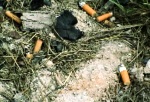
Even if the Rainbows were just using pure tobacco, the practice would be hazardous to the environment. Studies conducted by Clean Virginia Waterways show that the chemicals in cigarette butts easily leach out of the butts, and are deadly to water fleas (a small but important animal that lives in most freshwater lakes and streams as well as the ocean). The evidence indicates that the toxic chemicals leached from discarded cigarette butts present a biohazard to the water flea at concentrations of more than 0.125 butts per liter, or about one butt per two gallons of water. The leachate from the remnant tobacco portion of a cigarette butt is deadlier at smaller concentrations than are the chemicals that leach out of the filter portion of a butt.
Introduction of foreign species.
Every year, the Forest service finds pot plants growing throughout the area where the Rainbows gather. The seeds of non-native watermelons thrown into compost pits germinate and start growing in places where watermelons don’t belong. Countless other foreign species will be introduced into this fragile environment through garbage buried in shallow compost pits.
Animal Feces
The Rainbows do not believe in lease laws and allow their pets to roam freely. This practice contributes to tons of animal feces deposited in the environment.
1000 loose dogs x 275 grams of stool per day x 6 days = 1650000 grams or 1.82 tons of animal feces
Burning trash
When the Rainbows can’t come up with enough money to pay for dump fees, which happens often, they simply burn the trash on the land. This is not only unlawful, but releases toxins into the air. Rainbows claim to sort their recyclables into “7 Chakres” , but if a recycling center is not close to the wilderness area, it usually just gets taken to the nearest dump to add to existing waste problems.
FOREST FIRES
Last year in Wyoming, several wildfires were started in the area of the gathering by discarded cigarettes. Hopefully, the rain will lessen the danger of forest fires to the forest, but the rain will wash toxic chemicals into the water more effectively.
Add all these factors together, human feces, animal feces from pet dogs, urine, toxic chemicals from cigarette butts, chemicals from all the bleach, soap, shampoo, toothpaste etc, diapers, tampons, toilet paper, tin cans, plastic bottles and oil from vehicles in disrepair left behind. Remember, all these toxic substances are going to be deposited in YOUR NATIONAL FOREST over a period of 6 days! Not over a long time when the environment might have a chance to deal with such an influx of toxins, but over a period of 6 days!
So let’s add it all up:
23.14 tons of feces
22,222 gallons of urine (82.74 tons)
120 TONS OF TRASH
6 miles of compacted soil
18,900 tampons (0.87 ton)
3840 diapers (0.48 ton)
1/2 TON of soiled toilet paper
937.5 gallons of used toothpaste (3.26 tons)
937.5 gallons of soap (3.26 tons)
3,750 gallons of bleach (13.03 tons)
151.2 pounds of cigarette butts (0.06 ton)
1.82 tons of animal feces
Over 6 days, the Rainbows will deposit around 249.16 tons of waste in the Santa Fe National Forest.
That’s almost 250 TONS of WASTE just to pray for peace?????
Is all this harm to the environment really worth getting this many people together for a few minutes?
That is indisputably a huge footprint.
Thinking about the seventh generation, the footprint of the Rainbow Gathering this year may even outlive some of the Rainbow Family members.
We can only conclude, that the Rainbow Gathering is NOT a sustainable practice and should be discontinued for the good of our National forests.
Let’s do another thought experiment.
Let’s assume that the Rainbow Family really loves the planet as much as it professes.
If this is true, doesn’t it just make more sense for them to stay home and pray for peace?
If you love the earth, why go to an unspoiled section enmass and crap on it?
Why should our National Forests be so negatively impacted for an action that most religious people believe can be done anywhere at anytime?
Why do 10,000 people need to squat on public lands for 6 days in order to pray for peace for a few minutes at noon on the 4th of July?
Why not tell people to stay where they are and coordinate massive prayers over the internet?
Why not pray in an environment that can sustainably contain thousands of people?
If that environment doesn’t exist, then what is the Rainbow family doing to create it?
Why dig even one trench in our beautiful New Mexico wilderness?
TAKE ACTION
If these figures make you think the gathering is a bad idea, there are actions you can take.
Sign this petition
(www.ipetitions.com/petition/stoprainbowdisrespectin2009)
If you want to make sure that all this waste is removed from our National Forests and the creeks and streams are fully rehabilitated, you’ll have to make your voice heard.
Contact your elected officials
Insist that the Rainbow family take full responsibility for cleaning up their mess.
Twitter Barak Obama:
Ask that he hold the Rainbow Family accountable for TOTAL rehabilitation of the Rainbow Gathering site by FEDERAL standards, NOT by the standards of the Rainbow Family.
Contact the Forest Service and support them in doing everything to protect OUR National forests in New Mexico:
Paragraph #9 of the Permit Form, allegedly signed by a Rainbow reads as follows:
“The holder shall be liable for any injury, loss, damage, including fire
suppression costs and environmental harm or injury to natural
resources, that arises in connection with the use and occupancy
authorized by this permit.”
Write the Forest Service and see that the Rainbow Family is held to the terms of the permit.
Attention Mr. Lujan
United States Forest Southwestern Region.
Department of Service Regional Office Agriculture
333 Broadway SE
Albuquerque, NM 87102
FAX (505) 842 3800
V/TTY (505) 842-3292
Residents of New Mexico:
Contact your elected officials
New Mexico Governor Bill Richardson
Office of the Governor
490 Old Santa Fe Trail
Room 400
Santa Fe, NM 87501
Capitol Building 4th Floor Suite 400
Santa Fe, NM 87503
Telephone: (575) 476-2200
Fax: (575) 476-2226
Contact the Governor using this email form
http://www.governor.state.nm.us/email.php?mm=6&type=opinion
http://www.governor.state.nm.us/emailchoice.php?mm=6
Contact New Mexico Elected Officials (87013 zip code)
Use this New Mexico phone book
District 65 Representative James Roger Madalena
Co-Chair of Indian Affairs Committee
373 Buffalo Hill Road
Jemez Pueblo, NM 87024
Capitol Phone:
986-4417
Office Phone:
(575)867-3351
Home Phone:
(575) 834-7005
LOCAL REPRESENTATIVES FOR SANDOVAL COUNTY
Lynda Lovejoy
Member Indian Affairs and Indian and Cultural Affairs Committee
District 22 Senator Lynda M. Lovejoy
Box 705
Crownpoint, NM 87313
Capitol Phone:
986-4310
Office Phone:
(505) 352-0967
Home Phone:
(505) 786-7498
E-mail: lynda.lovejoy@nmlegis.gov
New Mexicans, write your State representatives:
Use this contact form
New Mexico Congressman
Senator Jeff Bingaman (D) bingaman@bingaman.senate.gov
SenatorTom Udall (D) tomudall@tomudall.senate.gov
http://tomudall.senate.gov/contact/contact.cfm
120 S Federal Place
Suite 302
Santa Fe, NM 87501
Phone (505) 988-6511
Fax (505) 988-6514
Senator Martin Heinrich (D)
https://forms.house.gov/heinrich/contact-form.shtml
20 First Plaza NW, Suite 603
Albuquerque, NM 87102
Phone: (505) 346-6781
Fax: (505) 346-6723
Congressman Harry Teague (D)
https://forms.house.gov/teague/webforms/issue_subscribe.htm
Congressman Ben R. Lujan (D)
https://forms.house.gov/lujan/contact-form.shtml
Ask the right questions to the right people.
For some reason, both the main stream media and the alternative media is reluctant to look into the true environmental impact of the annual Rainbow Family gatherings on our public lands. The facts have been presented above. You can decide for yourself if this gathering is sustainable. If any other group impacted our federal lands like this, what do you think would happen?
You can contact the alternative media and insist that the cover the gatherings objectively with the interests of environmental scientists in mind.
Question them about their position on dumping tons of feces on public lands. Question them about why they take the Rainbows word that they will clean up the area and that all that feces wont’ affect the wildlife in the area.
What do the Native Americans think of this use of their land? Were tribal leaders even consulted on the location of the site this year?
Why has there not been a single critical article written about the gathering?
This site was inspired by the National Geographic documentary,
http://www.snagfilms.com/films/title/human_footprint
and the hypocrisy of the Rainbow Family of Living Light.
JOIN US IN DISCUSSING ACTIVISM
Send us an email at sustainable.thought.box@gmail.com
Of if you attend NMSU:
We meet every Friday at noon in the Corbett Center
(look for a group of intelligent people wearing green)
Sources of information:
Don’t just take our word for it, check out our figures yourself.
Tufts University study of fecal fat and stool size
http://www.tufts.edu/med/nutrition-infection/tnc-cdaar/protocols/Fecal-Fat-Test.pdf
Online Medical Encyclopedia – study of the average urine produced per day
http://www.nlm.nih.gov/medlineplus/ency/article/003425.htm
NSDUH Report on smoking
http://www.oas.samhsa.gov/2k3/cigs/cigs.htm
A study done by Charmin Toilet Paper determined that an American uses 57 sheets of toilet paper per day.
http://encyclopedia.toiletpaperworld.com/fun-facts/toilet-paper-facts/
Phosphorus in dish soap harmful to water
http://www.ecy.wa.gov/programs/wq/nonpoint/phosphorus/PhosphorusBan.html
Cigarette Butts as Litter—Toxic as Well as Ugly
By Kathleen M. Register
http://www.longwood.edu/cleanva/ciglitterarticle.htm
Facts about Cigarette butt litter
http://www.longwood.edu/cleanva/cigarettelitterhome.html
NPR photos of Rainbow family latrines, compost pits and trash
http://www.npr.org/blogs/bryantpark/bpp_slideshows/2008/rfg/publish_to_web/index.html
Sensitive Eco-systems in the Cuba Ranger District of the Santa Fe National Forest
http://www.fs.fed.us/r3/sfe/wildlife/index.html
Sensitive Plants
Sensitive Animals
Articles critical of the Rainbows
I Speak of Dreams
Rainbow Family a Public Nuisance
http://lizditz.typepad.com/i_speak_of_dreams/2004/07/rainbow_family_.html
The Rainbow Gathering lacks one color — green
Writers on the Range – by Sharon Salisbury O’Toole
High Country News March 9, 2008
News Articles
Wildfire burning near Rainbow Gathering
By Cory Hatch, Jackson Hole, Wyoming
July 8, 2008
“A campfire near the site of this year’s Rainbow Gathering got out of control Monday afternoon and enveloped in flame roughly 3 acres of Bureau of Land Management property near Bridger-Teton National Forest.”
The fire prompted U.S. Forest Service personnel to evacuate two camps of Rainbow Family members near Bear Trap Meadows in the Big Sandy area about 31-miles southeast of Boulder.
“This is the second fire to burn in the area since the Rainbow Family began gathering at Big Sandy. On June 23, fire personnel extinguished a quarter-acre blaze near the Dutch Joe Guard Station in Bridger-Teton National Forest.
The cause of that fire is still under investigation. The June 23 blaze marked the first forest fire in the region for the 2008 fire season.”
We used Wikipedia and other reference sites to determines average usage of tampons, diapers and toiletries, rates of smoking, average stool size etc.
Statistics on shampoo soap and toothpaste use came from information online provided by frequent airline travelers trying to calculate how much liquid toiletries they need to pack for a short trip.
An excellent, although biased book, on Rainbow Cultural Appropriation of Native American Spirituality is Chapter 7, “Fakelore ‘, in Michael I. Niman’s book, People of the Rainbow: A Nomadic Utopia. You can still buy it on Amazon.
LINKS TO OTHER NEW MEXICO ENVIRONMENTALIST PAGES
Any of these fine organizations can guide you in learning how to protect New Mexico’s fragile environment.
Conservation Voters New Mexico Action Fund
http://www.wildearthguardians.org/
Native Plant Society of New Mexico
Nature Conservancy for New Mexico
http://www.nature.org/wherewework/northamerica/states/newmexico/
New Mexico Center for Environmental Law
New Mexico Wilderness Alliance
This website was created for purely educational purposes. It shows the impact of the Rainbow Gathering on the environment and exposes the hypocrisy of the Rainbow Family.
Nothing is for sale on this website.
FAIR USE NOTICE:
This site contains copyrighted material the use of which has not always been specifically authorized by the copyright owner. It is being made available in an effort to advance the understanding of environmental, political, human rights, economic, democracy, scientific, and social justice issues, and so on. It is believed that this constitutes a ‘fair use’ of any such copyrighted material as provided for in section 107 of the US Copyright Law. In accordance with http://www.law.cornell.edu/uscode/html/uscode17/usc_sec_17_00000107—-000-.html Title 17 U.S.C. Section 107,</a> the material on this site is distributed without profit to those who have expressed a prior interest in receiving the included information for research and educational purposes. If you wish to use copyrighted material from this site for purposes of your own that go beyond ‘fair use’, you must obtain permission from the copyright owner.
IF you support our right to have this website up,
JOIN THE ELECTRONIC FREEDOM FRONTIER’S BLUE RIBBON
<IMG SRC=”http://www.eff.org/br/br.gif”>
FREEDOM COMES WITH RESPONSIBILITY
AND
ONLY RESPONSIBLE PEOPLE ARE FREE
WHY?

